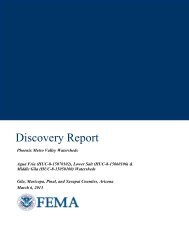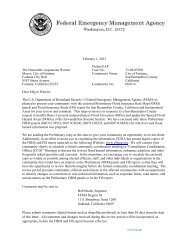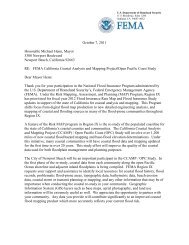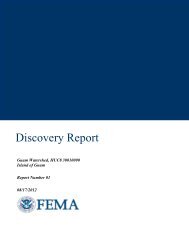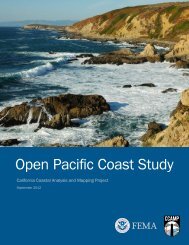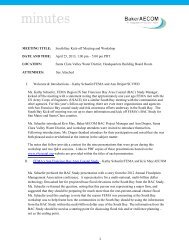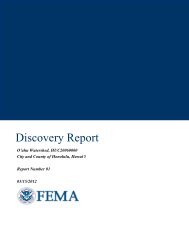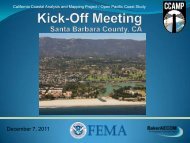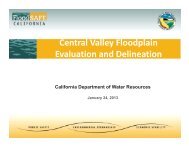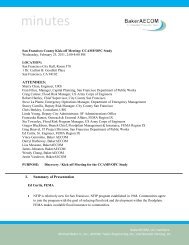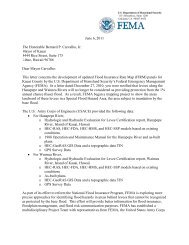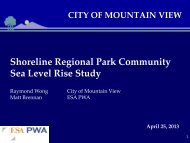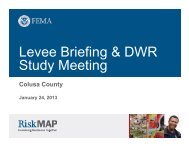YAVAPAI COUNTY, ARIZONA Federal Emergency ... - FEMA Region 9
YAVAPAI COUNTY, ARIZONA Federal Emergency ... - FEMA Region 9
YAVAPAI COUNTY, ARIZONA Federal Emergency ... - FEMA Region 9
You also want an ePaper? Increase the reach of your titles
YUMPU automatically turns print PDFs into web optimized ePapers that Google loves.
Problems created by large magnitude floodflow events on Del Monte Wash in the<br />
City of Cottonwood are a result of inadequate culvert capacity at the main stream<br />
crossing.<br />
An earthen levee exists on the north bank of Willow Creek between Willow<br />
Creek Road and Lorraine Drive in the City of Prescott. This levee was<br />
reconstructed at several sections in 1987, in order to provide protection from 1-<br />
percent annual chance floodflows for the Sandretto Hills Development, which is<br />
located along the north side of Willow Creek (<strong>FEMA</strong>, 1982, revised 1990).<br />
An organization was formed in 1978 in the City of Sedona area to predict<br />
flooding of Oak Creek and warn residents living in the vicinity so that evacuation<br />
of floodprone areas could be possible. The main purpose of the organization was<br />
protect life. Several small dikes and riprapped embankments have been<br />
constructed by private landowners along Oak Creek to protect their property from<br />
inundation and erosion during floods.<br />
There is a levee on the right bank (looking downstream) of Chino Valley Stream<br />
downstream of U.S. Route 89. Because the levee does not meet the requirements<br />
of Section 65.10 of the NFIP regulations, two flooding situations were evaluated<br />
for the 1-percent annual chance floodplain and floodway: flooding due to the<br />
levee failing and holding. Assuming the levee fails during the 1-percent annual<br />
chance flood, Chino Valley Stream will converge with Santa Cruz Wash,<br />
approximately 4,900 feet upstream of Old U.S. Route 89. Assuming the levee<br />
holds during the 1-percent annual chance flood, Chino Valley Stream will<br />
continue north along a different path for approximately 5,200 feet and converge<br />
with Santa Cruz Wash just upstream of Old U.S. Route 89. The floodway for<br />
Chino Valley Stream was determined assuming the levee fails during the 1-<br />
percent annual chance flood. Because Chino Valley Stream will follow a different<br />
path if the levee holds, a floodway was also determined for that reach.<br />
The Towns of Chino Valley and Prescott Valley, and the Cities of Cottonwood,<br />
Prescott and Sedona have passed floodplain regulations or zoning ordinances<br />
designed to delineate areas of flood hazards and to guide and regulate<br />
development within flood hazard areas so as to restrict future flood damage and<br />
flood hazards.<br />
3.0 ENGINEERING METHODS<br />
For the flooding sources studied in detail in the county, standard hydrologic and<br />
hydraulic study methods were used to determine the flood hazard data required for this<br />
FIS. Flood events of a magnitude which are expected to be equaled or exceeded once on<br />
the average during any 10-, 50-, 100-, or 500-year period (recurrence interval) have been<br />
selected as having special significance for floodplain management and for flood<br />
insurance rates. These events, commonly termed the 10-, 50-, 100-, and 500-year floods,<br />
have a 10-, 2-, 1-, and 0.2-percent chance, respectively, of being equaled or exceeded<br />
during any year. Although the recurrence interval represents the long term average period<br />
between floods of a specific magnitude, rare floods could occur at short intervals or even<br />
within the same year. The risk of experiencing a rare flood increases when periods<br />
greater than 1 year are considered. For example, the risk of having a flood which equals<br />
20




